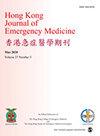院外心脏骤停后成功复苏患者引入治疗性低温的时机
IF 0.8
4区 医学
Q4 EMERGENCY MEDICINE
引用次数: 0
摘要
背景:治疗性低温可以改善心脏骤停幸存者的神经状况。目的:我们研究了院外心脏骤停患者诱导治疗性体温过低的时间与神经系统结果之间的关系。方法:我们评估了2013年1月至2017年4月期间116名自发循环恢复后昏迷的患者和接受治疗性体温过低的患者的数据。主要终点是指数住院期间的良好神经系统结果,定义为大脑表现类别得分为1或2。治疗性体温过低时间定义为从自发循环恢复到体温过低开始的持续时间。我们分析了早期低温诱导对神经系统结果的影响。结果:共有112名患者入选。体温过低开始的中位持续时间为284 最小值(第25–75百分位,171–418 分钟)。82名(69.5%)患者在6天内接受了体温过低治疗 h、 30例(25.4%)神经功能良好。低温起始时间四分位数(最短至最长)的神经系统良好结果率分别为28.3%、34.5%、14.8%和28.6%(p = 0.401)。6个月内体温过低患者的良好神经系统结果没有差异 h或之后(26.5%对26.7%,p = 0.986)。短的低流量时间和旁观者复苏与良好的神经系统结果相关(p = 0.044,置信区间:0.027–0.955),但低温开始的时间没有(p = 0.602,置信区间:0.622-1.317)。结论:在经历体温过低的院外心脏骤停患者中,较短的低流量时间与良好的神经系统结果相关。然而,即使在6岁以内,也能更快地引发体温过低 h、 没有改善神经系统的结果。因此,正如当前指南所建议的,在6 自发循环恢复的h是合理的。本文章由计算机程序翻译,如有差异,请以英文原文为准。
Timing of inducing therapeutic hypothermia in patients successfully resuscitated after out-of-hospital cardiac arrest
Background: Therapeutic hypothermia can improve neurological status in cardiac arrest survivors. Objectives: We investigated the association between the timing of inducing therapeutic hypothermia and neurological outcomes in patients who experienced out-of-hospital cardiac arrest. Methods: We evaluated data from 116 patients who were comatose after return of spontaneous circulation and those who received therapeutic hypothermia between January 2013 and April 2017. The primary endpoint was good neurological outcomes during index hospitalization, defined as a cerebral performance category score of 1 or 2. Therapeutic hypothermia timing was defined as the duration from the return of spontaneous circulation to hypothermia initiation. We analyzed the effect of early hypothermia induction on neurological results. Results: In total, 112 patients were enrolled. The median duration to hypothermia initiation was 284 min (25th–75th percentile, 171–418 min). Eighty-two (69.5%) patients underwent hypothermia within 6 h, and 30 (25.4%) had good neurological outcomes. The rates of good neurological outcomes by hypothermia initiation time quartile (shortest to longest) were 28.3%, 34.5%, 14.8%, and 28.6% (p = 0.401). The good neurologic outcomes did not differ between hypothermia patients within 6 h or after (26.5% vs 26.7%, p = 0.986). Short low-flow time and bystander resuscitation were associated with good neurological outcomes (p = 0.044, confidence interval: 0.027–0.955), but the timing of hypothermia initiation was not (p = 0.602, confidence interval: 0.622–1.317). Conclusion: A shorter low-flow time was associated with good neurological outcomes in out-of-hospital cardiac arrest patients who experienced hypothermia. However, inducing hypothermia sooner, even within 6 h, did not improve the neurological outcomes. Thus, as current guidelines recommend, initiating hypothermia within 6 h of recovery of spontaneous circulation is reasonable.
求助全文
通过发布文献求助,成功后即可免费获取论文全文。
去求助
来源期刊

Hong Kong Journal of Emergency Medicine
EMERGENCY MEDICINE-
CiteScore
1.50
自引率
16.70%
发文量
26
审稿时长
6-12 weeks
期刊介绍:
The Hong Kong Journal of Emergency Medicine is a peer-reviewed, open access journal which focusses on all aspects of clinical practice and emergency medicine research in the hospital and pre-hospital setting.
 求助内容:
求助内容: 应助结果提醒方式:
应助结果提醒方式:


